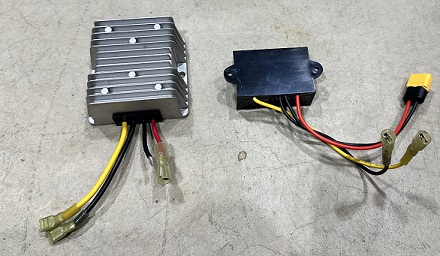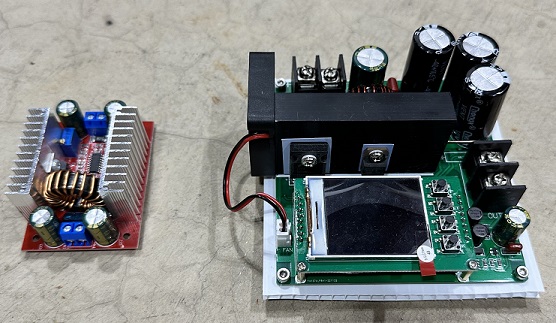
How to Increase 12 volts to 24 volts
Table of Contents
To increase 12 volts to 24 volts, you will need to use a boost converter or a fixed-voltage step-up regulator, which is basically just a boost converter set to a specific voltage and usually installed in some sort of housing. If you require a reduction from 24 volts to 12 volts, refer to the article "How to Reduce Voltage from 24V to 12V?" for guidance.
12v to 24v Through A Boost Converter
In the world of electronics, one of the core tasks often involves altering voltages to meet specific needs. To achieve this with Direct Current (DC), a boost converter is your best bet. This special kind of regulator applies precise control logic, high-speed signal manipulation, and an intricate understanding of electronics to amplify DC voltages.
Boost or Step-Up Converter for Increasing 12v to 24v
For straightforward operations where the task is to power basic 24-volt devices, a typical boost converter will suffice. However, if the requirement is a specific conversion from 12 volts to 24 volts, you may opt for a step-up converter. This device is essentially a pre-configured boost converter. It offers a fixed voltage output and a range voltage input, usually encased with attached wires for convenience.
Accounting for Current Requirements While Increasing Voltage
It's imperative to ensure that the chosen boost converter or step-up converter can support the required current. If you have a 12 to 24-volt boost converter running at 5 amps on the output, it'll draw double—10 amps—from the input. So make sure you size wires and fuses to account for the doubling of current on the input side. This phenomenon results from the essential principle that when voltage increases on the output side, the current correspondingly amplifies on the input side.
The opposite occurs when reducing 24v to 12v you will experience half the voltage on the input side when compared to the output side.
Make sure you keep in mind the current limits of your boost converter or step-up converter. This limit applies to the input primarily, as the input will always carry a higher current than the output. If the converter indicates a 10-amp limit, do not expect it to deliver 10 amps output; that 10-amp limit usually applies to the input, unless specified otherwise by the manufacturer.
[[ aff type=aff ~ link=https://amzn.to/3ZkSAuB ~ title=`12v to 24v Boost Converter` ~ image=https://admin.cellsaviors.com/storage/12-24v-boost-converter.jpg ~ description=`Easy to use 12v to 24v boost converter. A few available amperage ratings from this seller.` ~ height=small ~ buttonText=`Check Price` ]]
Ensuring Adequate Capacity and Cooling When Increasing 12v to 24v
When setting up a boost converter or step-up converter, it's always a good idea to avoid pushing the device to its absolute limits. For example, if your load requires 10 amps, it's advisable to invest in a converter rated for at least 15 amps.
Many converters available in the market, including those listed on platforms like Amazon, require active cooling in order to meet their advertised ratings. So, a converter that claims a 10-amp capacity might realistically handle only 5 or 6 amps without a fan. So, it’s important to consider this factor and oversize the converter accordingly. Doing this will prevent overheating and extend the lifespan of your converter.
How To Increase 12 Volts To 24 Volts To Charge A Battery
When considering the specific goal of using a 12-volt source to charge a 24-volt lithium-ion battery, there are additional important considerations. This process necessitates more than a simple voltage increase. You also have to maintain control over the charging current, ensuring it's regulated to meet the battery's specifications.
Understanding Cell Groupings and Voltage Requirements
To charge a 24-volt lithium-ion battery effectively, you first need to understand how the cells within the battery are arranged. Most commonly, these batteries consist of seven-cell groups in series. Each group needs to be charged to a voltage of 4.2 volts. Multiply the 4.2 volts per group by the seven groups and you'll arrive at the total required charge voltage: 29.4 volts. For an LFP battery, the math would be 3.6v multiplied by eight to give you 28.8v.
[[ aff type=aff ~ link=https://amzn.to/3y4sDDc ~ title=`Boost Converter` ~ image=https://admin.cellsaviors.com/storage/81c4URq5jjL._AC_SX679_.jpg ~ description=`Input voltage: DC 8-60V; Output voltage: DC 10-120V; Input current: 0-15A; Output current: 0-15A.` ~ height=large ~ buttonText=Check Price`` ]]
Why a Constant Current Boost Converter is Needed
Merely stepping up the voltage to this level isn't enough for proper charging, however. A constant current boost converter is required. Unlike a simple fixed voltage step-up converter, this device can ensure that the charging current is controlled and constant during the initial phase of charging. If you are looking to build a DIY lithium battery charger it is important to make sure the boost converter mentions it supports constant current and constant voltage (CC/CV).
Once the voltage reaches the level calculated earlier (4.2 volts per cell group), the charger switches to a 'constant voltage' phase. Now, the voltage is kept steady, while the current is allowed to decrease gradually. This two-stage charging approach is crucial to ensure the battery is charged safely and efficiently and to maximize its lifespan.
Simply using a fixed voltage step-up converter could risk overcharging or even damaging the battery if it fails to regulate the current properly during the initial charging stage.




